Detection-Oriented Evaluation of SAR Dexterous Barrage Jamming Effectiveness
Abstract
1. Introduction
- (1)
- The evaluation processes are characterized by one-sided and independent indicators, which cannot accurately reflect the changes in the overall quality of the jamming image.
- (2)
- The investigated jamming patterns are simple, reflecting that a comprehensive assessment of the effectiveness of dexterous barrage jamming with different shapes, areas, and magnitudes is lacking.
- (3)
- The existing research is stuck at feature-level and indicator-level evaluation, which do not consider detection-level evaluation and the feedback to the subsequent jamming employment.
2. Dataset Generation
3. Jamming Effectiveness Evaluation
3.1. Jamming Assessment in the Target-Detectable Stage
3.1.1. Target Exposion Area
3.1.2. Target Relative Magnitude
3.2. Jamming Assessment in the Target-Undetectable Stage
3.2.1. Jamming Relative Magnitude
3.2.2. Average Edge Brightness
3.2.3. Local Information Entropy
3.2.4. Determination of Normalization Constants
3.3. Two-Stage Integrated Assessment
4. Analysis of Experimental Results
4.1. Feature Parameters in Target-Detectable Stage
4.2. Feature Parameters in Target-Undetectable Stage
4.3. Detection-Oriented Jamming Evaluation
5. Discussion
6. Conclusions
Author Contributions
Funding
Data Availability Statement
Conflicts of Interest
References
- Chen, T.X. Research on Synthetic Aperture Radar Jamming Effect Evaluation Method. Master’s Thesis, Strategic Support Force Information Engineering University, Zhengzhou, China, 2023. [Google Scholar]
- Sui, R.; Wang, J.; Sun, G.; Xu, Z.; Feng, D. A Dual-Polarimetric High Range Resolution Profile Modulation Method Based on Time-Modulated APCM. IEEE Trans. Antennas Propag. 2025, 73, 1007–1017. [Google Scholar] [CrossRef]
- Quan, S.; Zhang, T.; Xing, S.; Wang, X.; Yu, Q. Maritime ship detection with concise polarimetric characterization pattern. Int. J. Appl. Earth Obs. Geoinf. 2024, 131, 103954. [Google Scholar] [CrossRef]
- Wang, J.; Quan, S.; Xing, S.; Li, Y.; Wu, H.; Meng, W. PSO-Based fine polarimetric decomposition for ship scattering characterization. ISPRS J. Photogramm. Remote Sens. 2025, 220, 18–31. [Google Scholar] [CrossRef]
- Yang, Y. Research on the Evaluation Method of SAR Jamming Effect Based on Autoencoder. Master’s Thesis, Xidian University, Xi’an, China, 2022. [Google Scholar]
- Han, G.Q.; Wu, X.F.; Dai, D.H.; Xin, S.Q.; Wang, X.S. Methods for evaluating the effects of SAR interference. Radar Sci. Technol. 2021, 1, 26–31. [Google Scholar]
- Tang, Z.Y. Research on Synthetic Aperture Radar Interference Suppression and Evaluation Technology. Ph.D. Thesis, University of Chinese Academy of Sciences, Beijing, China, 2022. [Google Scholar]
- Li, Y.C. SAR Active Deception Jamming Template Generation and Effect Evaluation Method. Master’s Thesis, Xidian University, Xi’an, China, 2019. [Google Scholar]
- Chen, T.Y.; Zhang, H.M.; Lu, F.H. A SAR jamming effect evaluation method based on AHP and target detection and recognition performance. Command. Control Simul. 2022, 44, 66–72. [Google Scholar]
- Luo, Q.; Zhu, S.B.; Tong, C.M. Evaluation of the effects of two SAR jamming methods. Inf. Electron. Eng. 2012, 1, 46–50. [Google Scholar]
- Ma, J.X.; Cai, Y.W.; Zhang, H. An evaluation method of SAR suppression jamming effect. Mod. Radar 2004, 10, 4–6+31. [Google Scholar] [CrossRef]
- Cui, R.; Xue, L.; Wang, B. Evaluation method of ISAR jamming effect based on equivalent view number. Syst. Eng. Electron. 2008, 30, 887–888. [Google Scholar]
- Shi, J.J.; Xue, L.; Bi, D.P. ISAR jamming effect evaluation method based on symmetric interaction entropy. Syst. Eng. Electron. 2010, 32, 119–121. [Google Scholar]
- Lu, H.T.; Lu, J.; Guo, J. A SAR jamming effect evaluation method based on correlation measure. Mod. Def. Technol. 2008, 36, 97–99. [Google Scholar]
- Han, G.Q.; Li, Y.Z.; Wang, X.S.; Xin, S.Q.; Liu, Q.F. SAR jamming effect evaluation method based on modified SSIM. J. Electron. Inf. 2011, 33, 711–716. [Google Scholar] [CrossRef]
- Liu, J.W.; Da, T.H.; Sun, J.L.; Wang, S.; Zhang, W.B. An intelligent evaluation method of SAR image jamming effect. Shipboard Electron. Countermeas. 2020, 43, 78–82. [Google Scholar] [CrossRef]
- Liu, Y.; Li, J.J.; Yang, L.L.; Xu, C. SAR jamming effect evaluation based on texture structure similarity and contour similarity. Mod. Electron. Technol. 2023, 46, 34–38. [Google Scholar] [CrossRef]
- Liu, P.J.; Ma, X.Z.; Wu, Z.G.; Wang, Y.; Liu, Z.H. SAR jamming effect evaluation based on BP neural network. Shipboard Electron. Countermeas. 2009, 29, 88–90+98. [Google Scholar]
- Han, G.Q.; Liu, Y.; Li, Y.Z. SAR jamming effect evaluation based on visual weighting processing. Syst. Eng. Electron. 2011, 9, 18–23. [Google Scholar]
- Ju, M.; Niu, B.; Hu, Q. SARGAN: A Novel SAR Image Generation Method for SAR Ship Detection Task. IEEE Sens. J. 2023, 23, 28500–28512. [Google Scholar] [CrossRef]
- Han, Z.; Wang, C.; Fu, Q. M~2R-Net: Deep network for arbitrary oriented vehicle detection in MiniSAR images. Eng. Comput. Int. J. Comput.-Aided Eng. Softw. 2021, 38, 2969–2995.x. [Google Scholar]
- Han, G.Q.; Li, Y.Z.; Xin, S.Q.; Liu, Q.F.; Yang, W.H. Evaluation method of deception jamming effect for new SAR. J. Astronaut. 2011, 32, 1994–2001. [Google Scholar]
- Jung, C.H.; Choi, M.S.; Kwag, Y.K. Parameter based SAR simulator for image quality evaluation. In Proceedings of the IEEE International Geoscience and Remote Sensing Symposium (IGARSS), Barcelona, Spain, 23–27 July 2007; pp. 1599–1602. [Google Scholar] [CrossRef]
- Li, F.; Zhu, W.Q. Research on evaluation method of active jamming effect against SAR. Aerosp. Electron. Warf. 2006, 22, 28–30+61. [Google Scholar]
- Wang, M.C.; Zhang, J.F.; Yang, Z.Y.; Liu, T. CFAR detection method of ship target on sea surface in polarimetric SAR image based on whitening filter under beta distribution. Acta Electron. Sin. 2019, 47, 1883–1890. [Google Scholar] [CrossRef]
- Wang, Y.H.; Chen, W.; Wang, J.F.; Li, Y.; Nie, X.Y. Fast target detection method in SAR image based on cascaded CFAR. Mod. Radar 2019, 41, 21–25. [Google Scholar] [CrossRef]
- Zhang, H.R.; Tang, Y.S. Design of SAR jamming signal generation system. Radar Sci. Technol. 2010, 8, 20–25. [Google Scholar]
- Kai, Y.; Li, Z. Jamming effect evaluation of anti missile radar based on fuzzy comprehensive evaluation. Ship Electron. Eng. 2015, 35, 76–79. [Google Scholar]
- Jiang, K.Y. Research on Online Evaluation Method of Radar Jamming Effect. Master’s Thesis, Xi’an Electronic Science and Technology University, Xi’an, China, 2023. [Google Scholar]
- Jiao, X.; Chen, Y.G.; Li, X.H. SAR jamming effect evaluation based on fuzzy reasoning. Syst. Eng. Electron. 2006, 4, 5. [Google Scholar]
- Wan, P.; Wang, J.G.; Zhao, Z.Q.; Huang, S.J. Edge extraction of small reflection target in SAR image. In Proceedings of the Conference on Targets and Backgrounds VI: Characterization, Visualization, and the Detection Process, Orlando, FL, USA, 24–26 April 2000; Society of Photo-Optical Instrumentation Engineers (SPIE): Bellingham, WA, USA, 2000; Volume 4029, pp. 141–146. [Google Scholar] [CrossRef]
- Sun, H.; Zhang, X.Y.; Ning, A.P. Application of particle swarm optimization fuzzy neural network in speech recognition. Math. Pract. Theory 2010, 40, 113–118. [Google Scholar]
- Zhang, Y.X.; Yang, R.Q.; Zhang, Y.X. Evaluation of satellite jamming effect based on fuzzy comprehensive evaluation. Fire Control Radar Technol. 2017, 46, 22–26. [Google Scholar] [CrossRef]
- Li, L.; Deng, F.; Peng, H.L. Constant False Alarm Rate Target Detection in Synthetic Aperture Radar Images. J. Test. Technol. North China Inst. Technol. 2002, 16, 9–13. [Google Scholar]


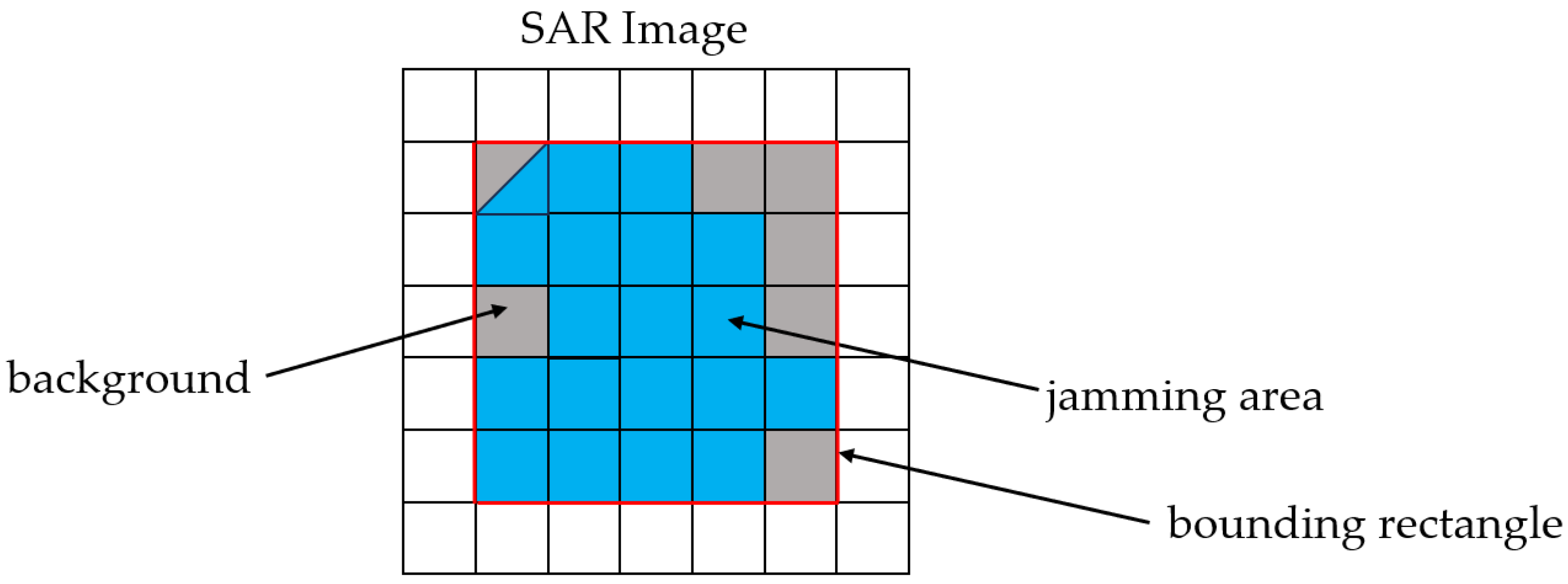

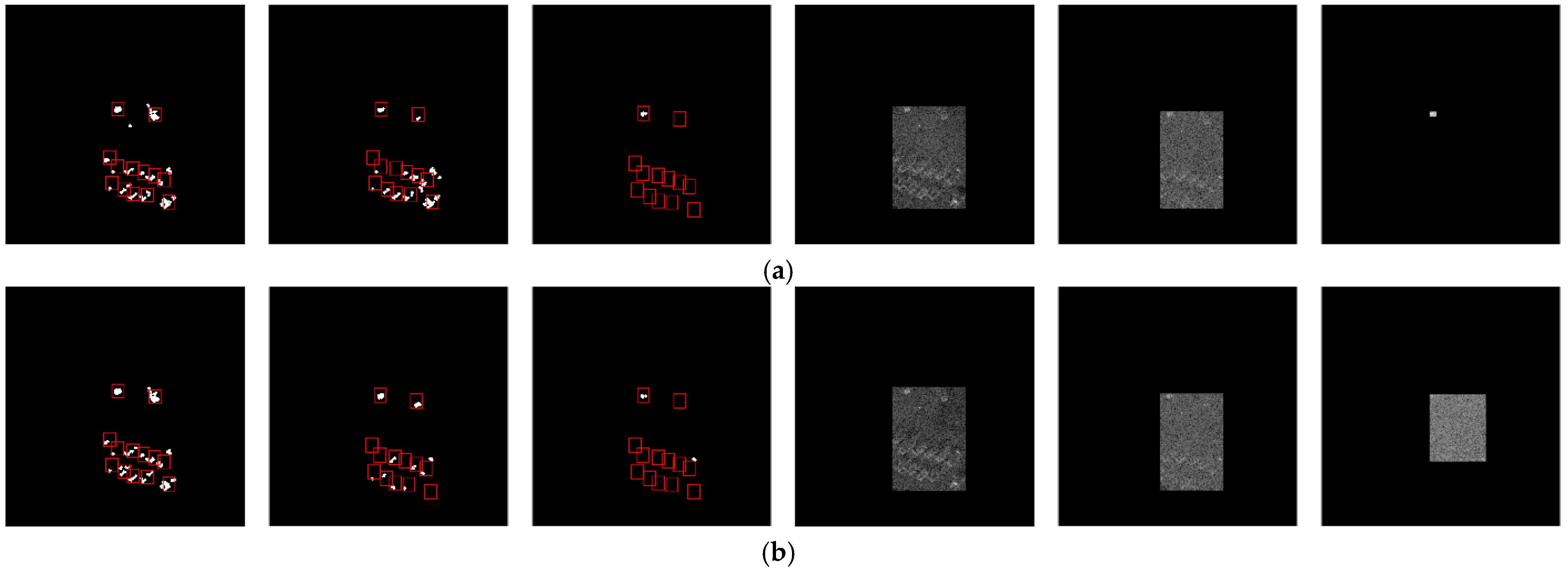


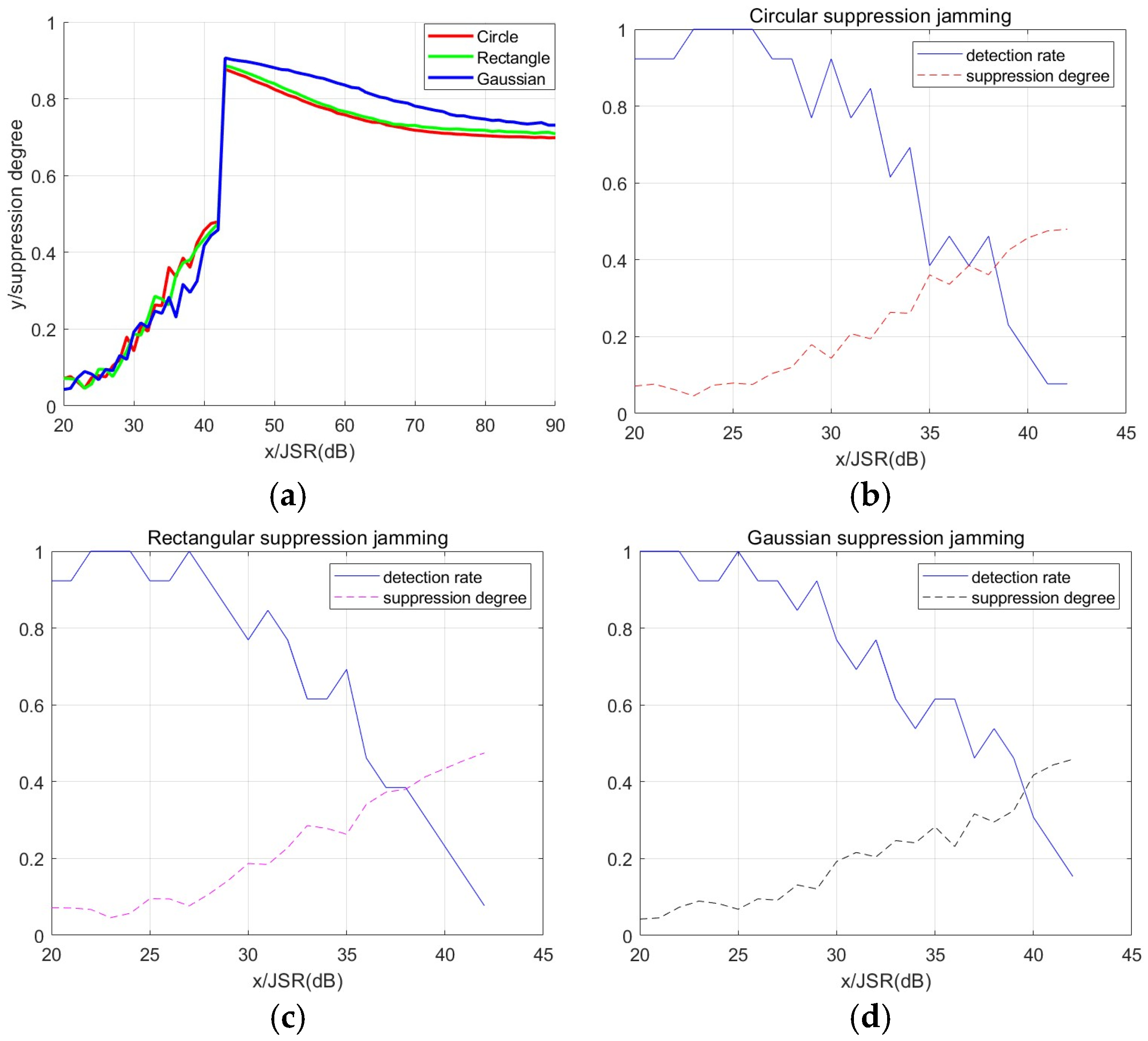
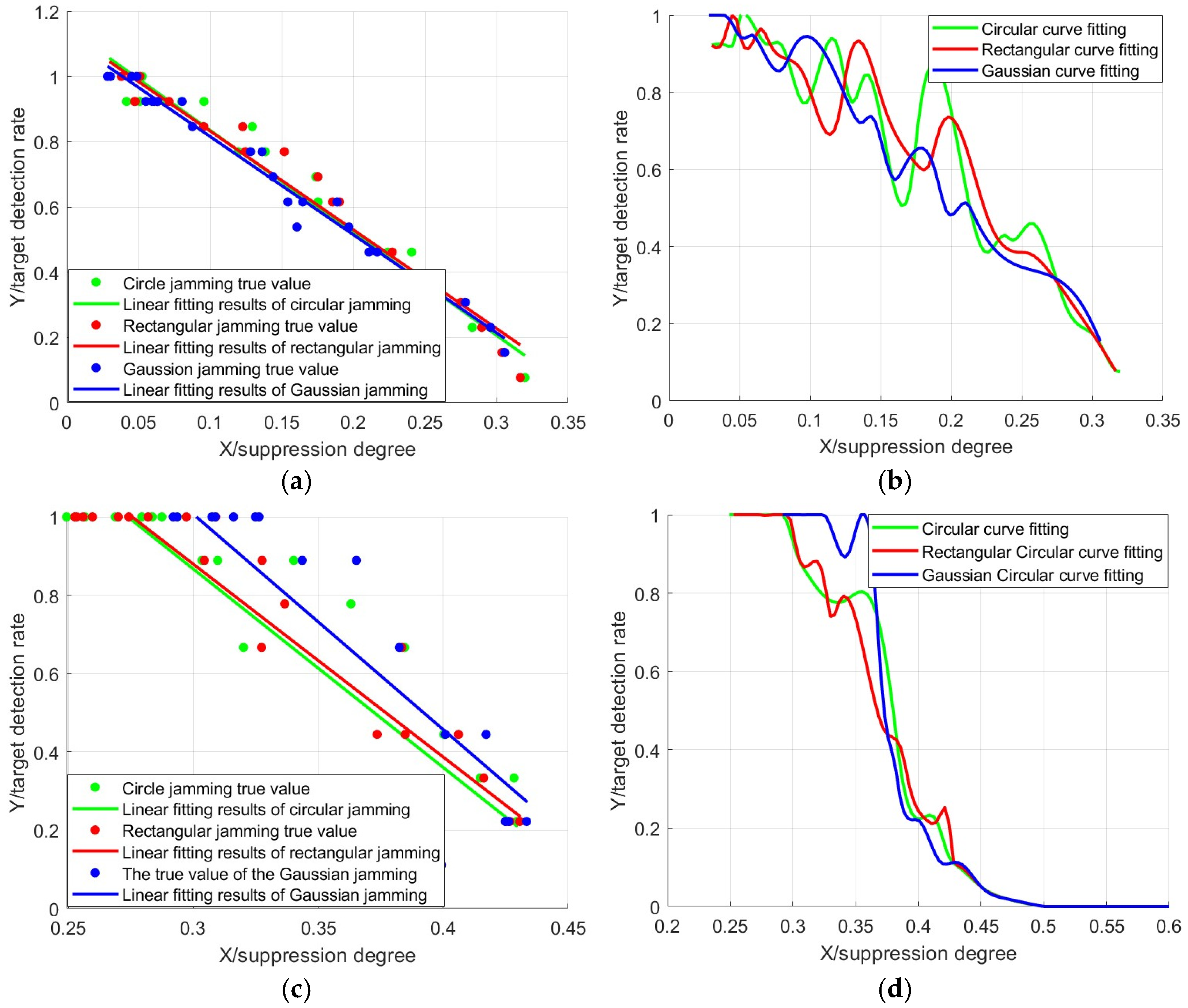
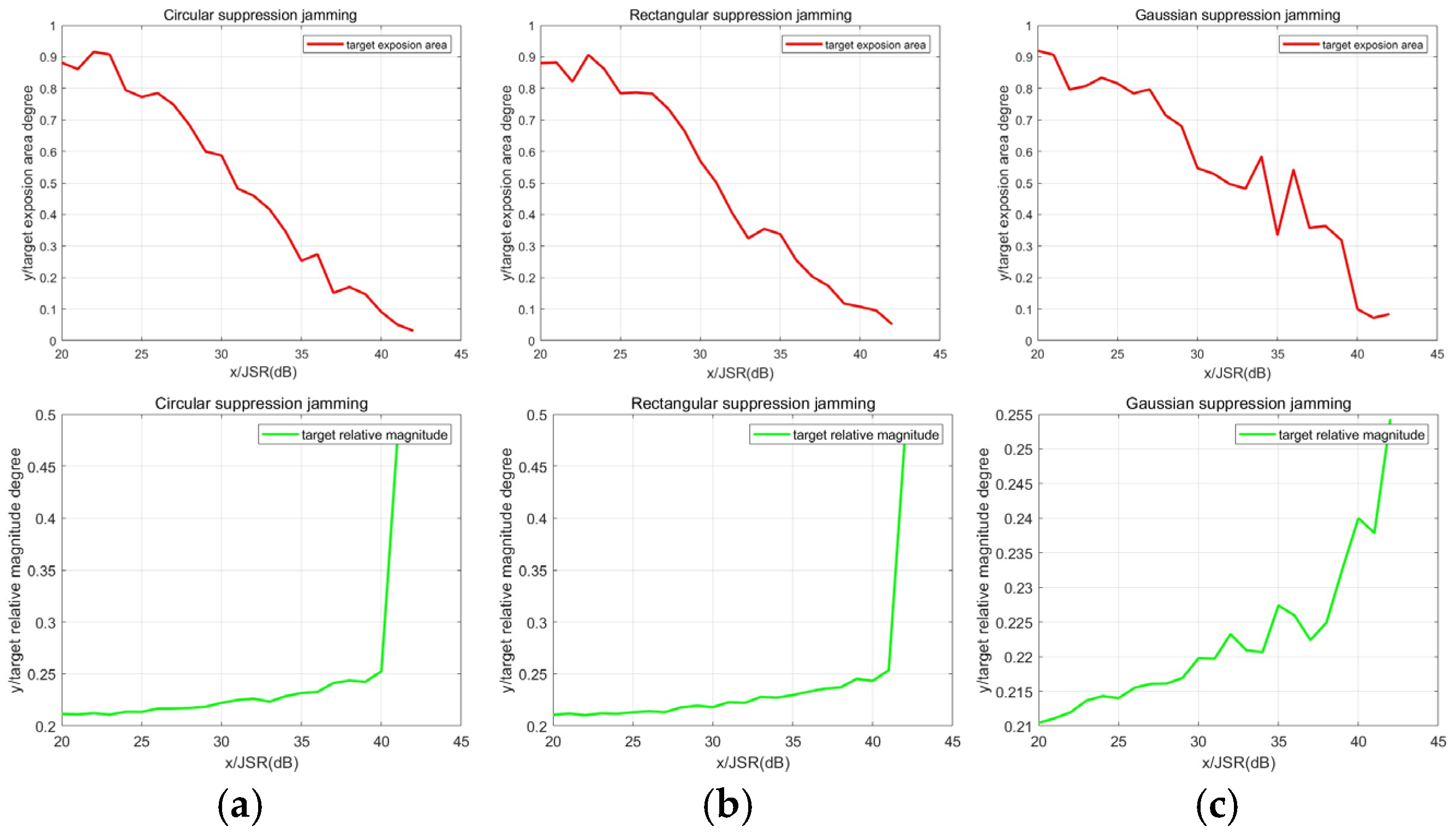


| Parameters | Descriptive |
|---|---|
| Carrier frequency | 10 GHz |
| Signal bandwidth | 200 MHz |
| Pulse width | 10 μs |
| Center slanting distance | 5 km |
| Platform speed | 200 m/s |
| Target Exposure Degree () | Jamming Concealment Degree () | |
|---|---|---|
| target exposion area () | [0.0, 1.0] | — |
| target relative magnitude () | [0.4, 1.0] | — |
| jamming relative magnitude () | — | [0.1, 0.5] |
| average edge brightness () | — | [0.2, 0.4] |
| local information entropy () | — | [0.0, 1.0] |
Disclaimer/Publisher’s Note: The statements, opinions and data contained in all publications are solely those of the individual author(s) and contributor(s) and not of MDPI and/or the editor(s). MDPI and/or the editor(s) disclaim responsibility for any injury to people or property resulting from any ideas, methods, instructions or products referred to in the content. |
© 2025 by the authors. Licensee MDPI, Basel, Switzerland. This article is an open access article distributed under the terms and conditions of the Creative Commons Attribution (CC BY) license (https://creativecommons.org/licenses/by/4.0/).
Share and Cite
Zhu, H.; Quan, S.; Xing, S.; Zhang, H.; Ren, Y. Detection-Oriented Evaluation of SAR Dexterous Barrage Jamming Effectiveness. Remote Sens. 2025, 17, 1101. https://doi.org/10.3390/rs17061101
Zhu H, Quan S, Xing S, Zhang H, Ren Y. Detection-Oriented Evaluation of SAR Dexterous Barrage Jamming Effectiveness. Remote Sensing. 2025; 17(6):1101. https://doi.org/10.3390/rs17061101
Chicago/Turabian StyleZhu, Hai, Sinong Quan, Shiqi Xing, Haoyu Zhang, and Yun Ren. 2025. "Detection-Oriented Evaluation of SAR Dexterous Barrage Jamming Effectiveness" Remote Sensing 17, no. 6: 1101. https://doi.org/10.3390/rs17061101
APA StyleZhu, H., Quan, S., Xing, S., Zhang, H., & Ren, Y. (2025). Detection-Oriented Evaluation of SAR Dexterous Barrage Jamming Effectiveness. Remote Sensing, 17(6), 1101. https://doi.org/10.3390/rs17061101








